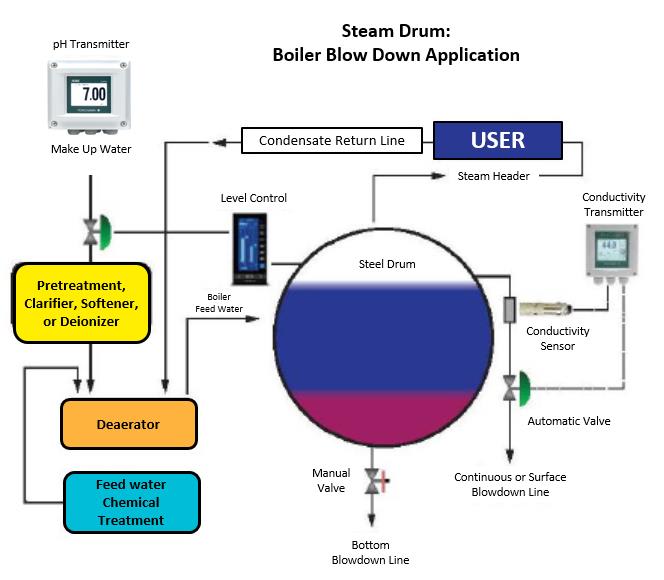Whether a boiler should be repaired or replaced is largely dependent on age and condition. Proper monitoring of water quality (pH, Cond, DO), chemical addition control (ORP), and real-time corrosion control (ECP). Regular maintenance is important to prolonging the life of a boiler. However continuous monitoring of water quality allows for predictive maintenance and prevention of shutdown.
Where and What Should be Monitored?
For the Pure Water applications, the primary measurement we encounter is conductivity but we have offered pH/ORP, and Dissolved Oxygen configurations as well for over 15 years with great success.
Pure Water Applications

Quick Run Down of Applications:
- Reverse Osmosis Filters
-
- Conductivity: Ratio % Passage/Rejection (two sensors)
- pH occasionally, for membrane life
- Demineralizers
-
- Cation, Anion, Mixed Bed
- Cation
-
- Cation Conductivity (two sensors in ratio)
-
- Charged Cation Beads "remove" (change to acid) positive Ions and release H+ into the stream
- Cation Conductivity has special Temp Comp to take the H+ into account
- % Concentration (1 sensor)
-
- Beads are regenerated with acid (typically HCL or H2SO4)
- Anion
-
- Specific Conductivity (1 or 2 sensors)
-
- Charged Beads "remove" (change to water) negative ions
- % Concentration (1 sensor)
-
- Beads are regenerated with Caustic (NaOH)
- pH occasionally
-
- Completeness of after-regeneration Rinse
- Mixed Bed ("Polisher")
-
- Specific Conductivity (1 sensor)
-
- Removal of both +/- Ions ("fine" cleaning, < 0.1 uS/cm)
- pH occasionally for complete monitoring
- Deion Storage
-
- Specific Conductivity (1 sensor)
-
- Ensure Water Quality after storage
- Second Polisher
-
- Specific Conductivity
-
- Final cleaning (Boiler applications)

To defray energy costs, many industrial plants have their own boilers to generate steam to produce a portion of their energy needs. In addition, the steam may also be used directly in plant processes or indirectly via heat exchangers or steam jacketed vessels.
The Problem for this application is that the raw water used to feed the boilers contains varying levels of impurities that must be removed to protect the boiler and associated equipment. Pretreatment processes such as reverse osmosis, ion exchange, filtration, softening and demineralization may be used to reduce the level of impurities, but even the best pretreatment processes will not remove them all and there will be a continuous carryover of some dissolved mineral impurities into the boiler.
Boiler feed water usually contains one limiting component such as chloride, sulfate, carbonate, or silica. Even if the component is not conductive, for example, silica, its concentration is usually proportional to a component that can be measured by conductivity; therefore, conductivity is a viable measurement for monitoring the overall total dissolved solids present in the boiler. A rise in conductivity indicates a rise in the "contamination" of the boiler water. So, measuring the conductivity of the feed water is important to this application.
The most common methodologies used for boiler blowdown control include: (1) continuous, (2) manual, and (3) automatic. Continuous blowdown utilizes a calibrated valve and a blowdown tap near the boiler water surface. As the name implies, it continuously takes water from the top of the boiler at a predetermined rate to reduce the level of dissolved solids. The rate is usually set slightly greater than necessary to be on the safe side.
Manual blowdown is accomplished at most plants by taking boiler water samples once a shift and adjusting the blowdown accordingly. This grab sample approach means that operators cannot immediately respond to changes in feedwater conditions or variations in steam demand and scaling conditions can occur and go undetected until the next sample check.
Automatic blowdown control is achieved by constantly monitoring the conductivity value of the boiler water and adjusting the blowdown rate and duration based on a specific conductivity set point. This provides control of the water chemistry regardless of the boiler load conditions. Actual operation data verifies that automatic control can maintain boiler water conductivity consistently within 5% of the set point. Manual blowdown control cannot maintain this level of control more than 20% of the time. Again, measuring conductivity is essential for controlling this application.
Want More Detailed Information?
Applications Notes
Technical Information